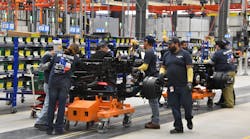Manufacturing Growth Is Strong. So Why Are We Subsidizing It?
ANALYSIS
A loss of manufacturing jobs and a declining share of manufacturing in affluent western economies, both real and painful, have etched a deep impression in public perception that manufacturing in the West is in trouble. For some politicians, protecting domestic manufacturing has become a rallying cry. It is a rare issue where President Biden and former President Trump seem to align. Passionate advocates are calling for new subsidies, tax breaks, tariffs, regulations and other measures. Before jumping into action, however, it would be good to examine exactly how dire the situation is.
The gloomy picture is understandable. In the U.S., the share of manufacturing jobs has declined from about 15% of non-farm employment in 1997 to about 8% in 2020, and the share of manufacturing value added to the gross domestic product (GDP) has declined from about 16% in 1997 to about 11% in 2020. Other rich countries are experiencing similar trends.
But these numbers do not mean that the manufacturing sector is necessarily shrinking. Manufacturing can continue to grow despite shedding jobs if it increases labor productivity sufficiently. The declining share of manufacturing in the GDP could be due to faster growth in other sectors. A better way to find how a sector is doing is to examine how much value it is generating.
If you look at the value added by the manufacturing sector in rich western economies, the picture is not gloomy. In the U.S., for example, despite the sensational headlines and anecdotal evidence of demise of manufacturing in certain industries in recent years, total value-added in manufacturing actually rose from $1.38 trillion in 1997 to $2.34 trillion in 2020 (in nominal dollars, and by a small amount after adjusting for inflation).
The U.S. is the second largest manufacturer in the world (after China), and in 2020, with less than 5% of the world’s population, generated almost 15% of the worldwide value added in manufacturing. China, the so called “factory of the world,” with almost 20% of the world’s population, generated only about 30% of the world manufacturing value-added.
Putting it differently, per capita, the U.S. generated 2.4 times more value-added in manufacturing (in nominal dollars) than did China ($6,610 in the U.S. versus $2,780 in China). Some of the other rich countries generated even more. Per capita, South Koreans and Japanese generated 2.9 times, Germans 3.2 times and Swiss 5.5 times more than the Chinese. Seven of the world’s richest countries—the U.S., Japan, Germany, South Korea, Italy, France, United Kingdom—were among the top 10 largest manufacturers in the world in 2019.
Looking at these numbers, it is hard to argue that manufacturing is in trouble in these countries. Does the West really need to resort to restrictive trade practices, generous subsidies, new regulatory barriers, and other such measures to protect its manufacturing? In a few sensitive industries (such as microchips, EV batteries, or certain pharmaceuticals or defense-related products), we may need some of these measures. But extending them beyond a finite and carefully selected set of industries would be unwarranted and unwise. Rather than erecting protective walls around domestic manufacturers, it would be better to help them strengthen their capabilities to connect to the world (global suppliers, markets, technology leaders, logistics providers and others in their ecosystems). That would allow them to exploit the advantages of being in an advanced economy.
Look at where multinationals are building their new factories. Roughly half of greenfield foreign direct investment (FDI) in most countries is for building new factories (the rest is for building power plants, telecom networks and other infrastructure facilities). In 2020, the total greenfield FDI in the world was $660 billion, and $400 billion of it went to developed countries.
The biggest recipient, as usual, was the U.S., receiving $85.9 billion, more than twice the amount received by the second and third largest countries, United Kingdom ($44.5 billion) and Germany ($40.5 billion), and almost three times that of China ($31.5 billion).
We ought to dispel the notion that manufacturing needs to be in a low labor-cost environment to prosper. Most managers seem to know this already. In a 2018 survey by the Brookings Institution, using 20 indicators in five categories—policies and regulations; tax policy; energy, transportation and health costs; workforce quality; and infrastructure and innovation—senior managers ranked the 10 most attractive countries for manufacturing as Britain (this was before Brexit!), Switzerland, United States, Japan, Canada, Netherlands, South Korea, Germany, Spain and France (China was ranked No. 13).
Next time you hear that manufacturing is leaving the rich world, remember a simple fact: Faster growth of manufacturing in China or other countries does not mean it is declining in the rest of the world. Countries compete in selling manufactured items, but that does not make global manufacturing a zero-sum game. Rich countries, already home to a great deal of manufacturing, can continue to grow this sector.
Making careers in manufacturing attractive to young talent in the West is crucial—and a challenge. A first step is to convince them that, despite what they often hear in the news, manufacturing is thriving in their countries.
Kasra Ferdows is Heisley Professor of Global Manufacturing at Georgetown University McDonough School of Business. This is based on his article “Manufacturing is not leaving the rich world,” forthcoming in Management Business Review.
***To comment on this article, please scroll down past story recommendations to "Voice Your Opinion."




